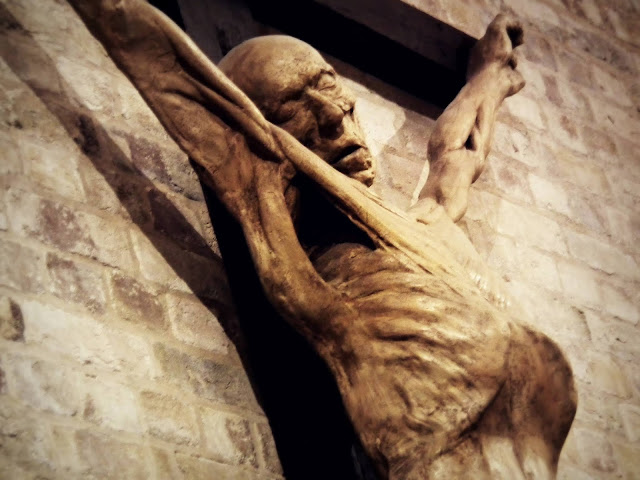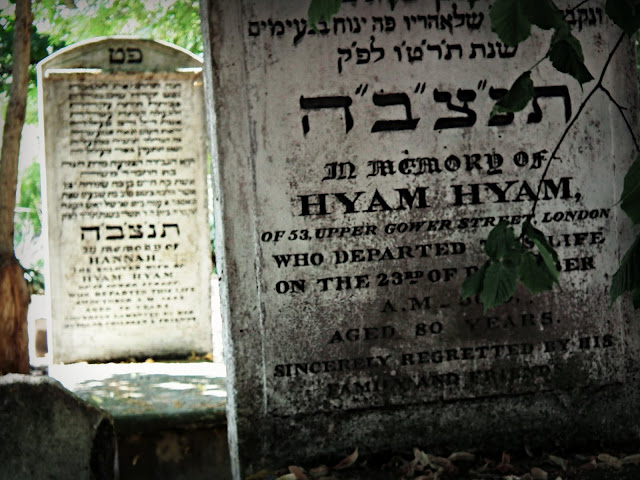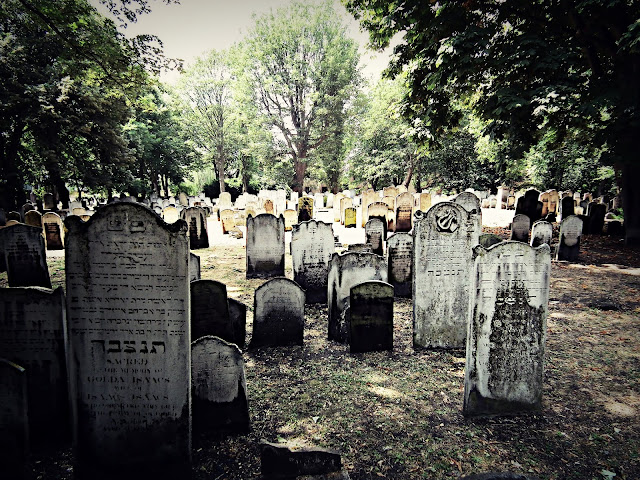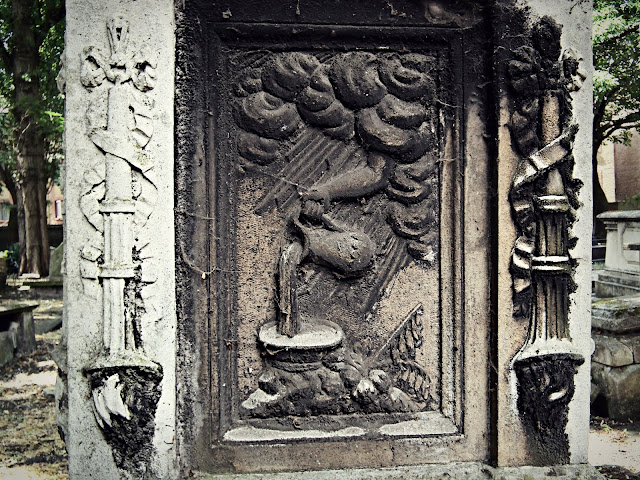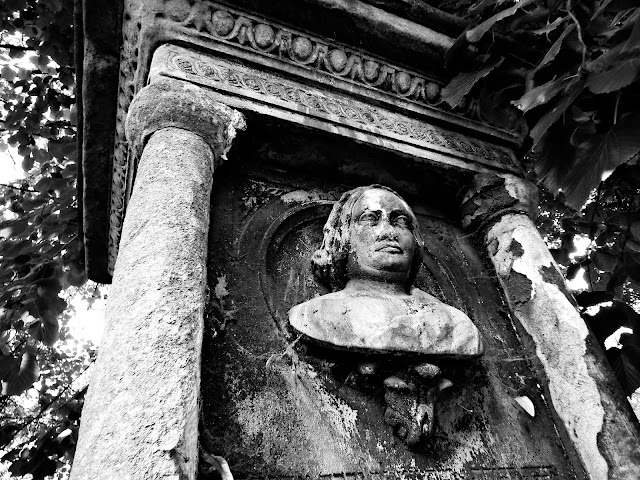In May the Royal Academy finally opened the doors to its £56 million redevelopment
to the public. The event received much coverage in the media including
terrestrial TV news coverage. I was watching it on Channel 4 news which took
you on a tour of the new gallery spaces, the new bridge linking Burlington
House with the Burlington Gardens building, the refurbished vaults and the new
auditorium. They were interviewing someone, possibly Tim Marlow the RA’s
recently appointed Artistic Director; I wasn’t really listening because my
attention was transfixed by something in the background to the interviewee’s
head shot. A life size model of a man being crucified. Some change in my
demeanour, a shifting forward in my seat, widening of the eyes, a sharp intake
of breath, I’m not sure what, alerted my wife that that I was taking more than
usual interest in the programme.
“What
is it?” she asked. I pointed to the crucifixion behind the interviewee’s neatly
trimmed hair.
“That’s
James Legg, the Chelsea pensioner, who was executed for murder then handed to
the anatomists, who crucified him in an experiment then flayed his corpse and
made a plaster cast…” I told her. She rolled her eyes and went back to leafing
through her magazine, taking no further interest in the subject. I was much
more interested in the 200 year old plaster cast than I was in the £56 million
refurbishment of the Royal Academy. James Legg normally languishes in the RA’s
vaults, seen only by students. He has occasionally been put on public view over
the last two centuries but his public appearances are normally pretty brief and
I have never managed to catch one of them. From the news report he looked to be
on prominent display. I went to see him this week, the first opportunity I have
had since seeing the news item in May, and didn’t even bother looking round the
new gallery spaces, the new bridge or the new auditorium. I only had eyes for
James.
On
October 28 1801, 70 year old Chelsea Pensioner James Legg was convicted of the
murder of fellow pensioner William Lambe at the Old Bailey. The only witness to
the murder was Lambe’s wife. She told the court that she was surprised that Legg, whom she had known
for years, had shot her husband with a pistol because “I
took him to be a very solid man, for he washed his own linen, cooked his own
victuals, and took the sacrament regularly…” But on the morning of October second,
in the common room of the Royal Hospital Mrs Lambe got up a little before seven
to find Legg walking about “swearing, and quite in an ill humour, I thought; I
asked him what was the matter, when he began to swear the more, and said, I
will turn you out of the room, if you speak another word.” William Lambe was still in bed, perhaps Legg’s
threats to his wife woke him up for when she opened the door to their room he
was just getting up. Legg brushed past her and put a pistol into his hand.
Still half fuddled with sleep Lambe, according to his wife “took it, turned it
about, and looked at it, and said, what is this for; the room was dark, and
then he threw it into the common room; my husband had just put on a little
flannel waistcoat, and stood up against the door.” Legg rushed up to him and
fired his own pistol into Lambe’s chest, killing him immediately; “he
endeavoured to call my name, but could not…” said Mrs Lambe pathetically. Legg
seemed to be challenging Lambe to a duel, newspapers reported that he had said “You
must get up and fight me,” as he threw the gun at Lambe but when the pistol was
examined later it was found to be primed with gunpowder but to contain no
bullet.
 |
| A Chelsea Pensioner in uniform |
None
of the witnesses at the trial had any idea why James Legg would want to kill
William Lambe. When questioned Charles Coates, another pensioner and one of the
first on the scene after the shooting told the court “I said, good God, why you
have killed him, he is quite dead, how could you do so; he (Legg) paused, and
said, I gave him a pistol in his hand, to come out and fight me like a man, he
would not, but threw it down, then I fired….” The newspapers had reported that
the two men had been at loggerheads over the coal ration but this seemed a poor
motive for murder. So senseless did the killing seem that some witnesses
suggested Legg was out of his mind.
Joseph Ryland, a tobacconist, swore that Legg did not seem in his right
senses “This year past, he used to buy tobacco of me; one day, about half a
year ago, he talked very wild, and said he was going to have a company, and be
in commission afresh, under Lord Cornwallis in Ireland.” Ann Grant a nurse at
the Old Infirmary testified “the prisoner was in the hospital, under my care,
from the beginning of the year to the 10th or 11th of May; and, during that
time, I saw a very great change in him, which I never saw before; a lowness, a
melancholy and deranged state; knowing him so long, I took the opportunity of
asking him what was the matter with him, and the reason of his melancholy; he
told me his mind was confused; that he had no rest night or day; that he was
hurried from place to place, and could not tell what he was doing; and I really
was afraid he would make away with himself.” Mr Justice Heath was not swayed by
this thin evidence of insanity and finding Legg guilty condemned him to death by
hanging and, once dead, to anatomisation by the surgeons.
There
was great public interest in James Legg. The Morning Post reported the scenes at Newgate Chapel the following
Sunday when the condemned sermon was due to be read:
On Sunday morning
a great number of persons attended the Old Bailey chapel to hear the condemned
sermon. The principal objects of attraction were Smith, the pretended Parson,
and Leigh, the Chelsea pensioner, both capitally convicted last week... The
price of admission was at first a shilling; it soon rose to two shillings, and
shortly after to three. From the increasing demand for places, and the affluent
appearance of the visitors, the door keepers now thought they might sport box
prices, and were on the point of demanding a crown a-head but unfortunately the
place by this time was completely full, and the reflux of a disappointed tide
put an end to any further solicitation for admittance. Still, however, numbers
hovered about the place,
waiting to receive an account of what
passed within from their more lucky friends. From this state of suspense and
expectation they were relieved much sooner than they could have had reason to
hope. No condemned sermon was preached, the unfortunate objects of their
curiosity did not appear in the Chapel, and the audience were dismissed after a
short prayer. This disappointment was followed with loud murmurs against the
Chaplain, and loud demands to have their money returned and, strange to tell,
many Gentlemen did not leave Newgate without actual compulsion.
 |
| The condemned sermon being read at Newgate Chapel |
The
same newspaper also gave a full account of the execution the following day:
Yesterday morning,
a few minutes after eight o’clock, James Legg, the Chelsea pensioner, and
Richard Stark, who were both convicted of murder at the present Old Bailey
Sessions and ordered for execution were launched into eternity, opposite the
debtors door of Newgate amidst the execrations of many thousand spectators who
were assembled as early as half past seven o'clock, to witness their behavior at the place of execution.
Legg’s manner was
as unconcerned during his confinement in the condemned cell as on his trial…. Throughout
the whole of his confinement, he betrayed no fear of death, was always
collected; and when he was about to ascend the scaffold, he took Mr. Kirby by
the hand, and said, "I mind this no more than I would entering the field
of action”. He afterwards shook hands with all around him, and turning to his
companion Stark, who was weeping bitterly, said, 'Be a man, and die with
spirit." He made use of many other exhortations, and so far succeeded as
to make Stark hold up his head. Before they were turned off, Legg looked
around, bowed to the populace, smiled, and appeared quite unconcerned. After
hanging the usual time (an hour), their bodies were carried to the dissecting-room
on Saffron-hill and this day they will be exhibited for public inspection. Legg
was in the 25th regiment of foot about sixteen years, was born in Shropshire….
His appearance was prepossessing, an open countenance, about six feet one inch
high.
Écorché
The intention of the court was that Legg should be publicly dissected but the corpse was claimed by a staff surgeon at the Chelsea Hospital, Joseph Constantine Carpue, who had agreed to take part in an unusual experiment at the request of three prominent artists, Thomas Banks, Richard Cosway and Benjamin West. All three were Royal Academicians; West was in fact the second President, having taken over the position left vacant on the death of Sir Joshua Reynolds. Banks was a celebrated sculptor, Cosway a portrait painter and the Anglo-American West a painter of historical subjects. These three distinguished men had been debating for some time the questionable anatomical accuracy of crucifixion scenes. They approached Carpue to help them determine the exact effects being nailed and hung from a cross would have on the human body. Conducting the experiment on a live human being would be likely to land them all in serious trouble so they settled on the next best option, experimenting with a fresh corpse. |
| Thomas Banks |
 |
| Benjamin West |
 |
| Richard Cosway |
According
to Carpue, Legg’s body was removed to a temporary building “erected near the place of the execution; a cross provided. The subject
was nailed on the cross; the cross suspended…the body, being warm, fell into
the position that a dead body must fall into…When cool, a cast was made, under
the direction of Mr Banks, and when the mob was dispersed it was removed to my
theatre.” Carpue then flayed the crucified corpse, removing every shred of
skin and subcutaneous fat to expose the muscle beneath. Banks made another
plaster cast of the body, a classic ecorché. Both casts were later displayed in
Banks studio, creating huge public interest before being moved to the Royal
Academy where the sculptor hoped they 'might be useful to the Students of the
Royal Academy & also to the professor of Anatomy at the time of his giving
his lectures as they may be mov'd from the Antique Academy to the Lecture room
& back again with very little trouble'. In the 1820’s they were moved to
Carpue’s own museum of anatomy. St George’s Hospital inherited the two casts
from Carpue and during the First World War the ecorché ended up back at the
Royal Academy. The other cast has been lost.

